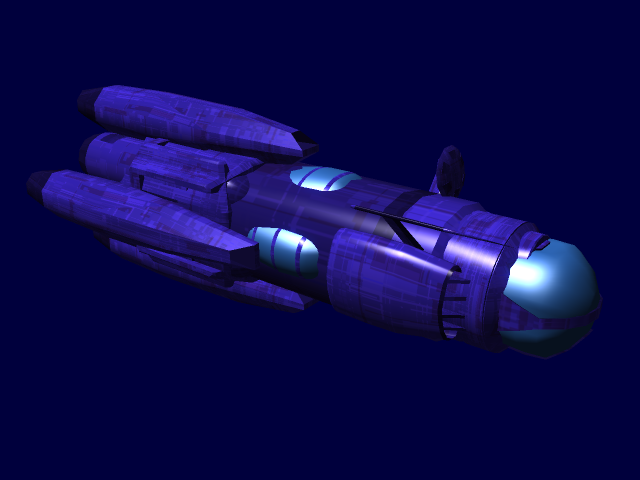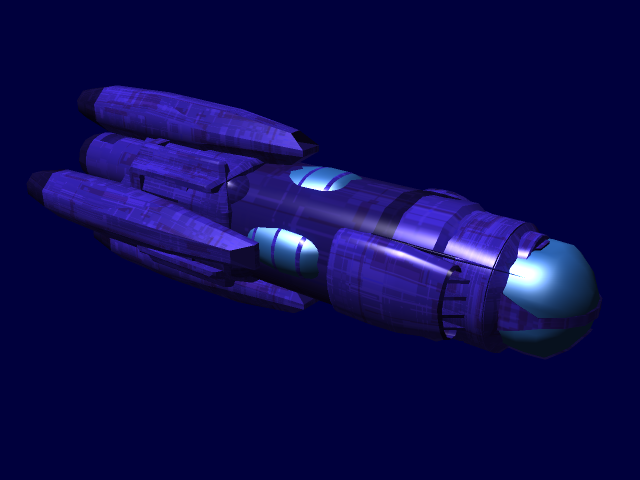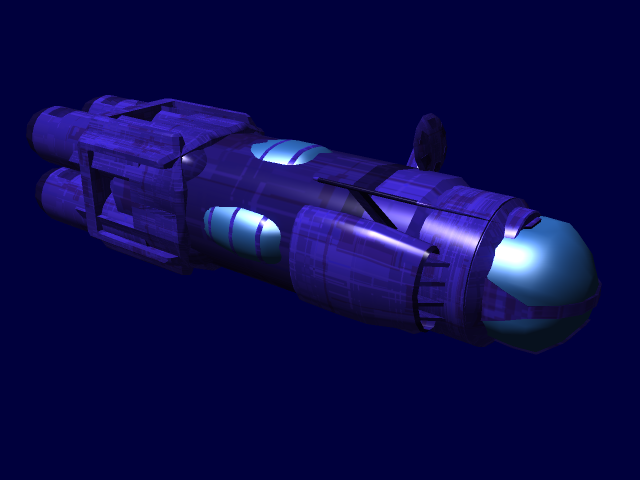Sidebar
Table of Contents
Nimiss Scoutship
About the Nimiss
The Nimiss was built to escape the extremely harsh atmosphere of Azorea. The ship was built with a blunt nose containing the bridge, and then a cylinder body until the aft section, which transforms into more of a square to house four ion thrusters. Without wings or a decent self-propelling system, it requires several equally sized rockets to escape an atmosphere, but once in space, some of the rockets are disconnected. The remaining rockets allow for bursting to a top speed and/or allow turning, while the ion thrusters allow you to maintain the speed after the rockets are turned off. It can replenish fuel for the rockets by absorbing hyrdrogen in space using the hydrogen collectors located to either side of he nose at the beginning of the middle section of the ship. The Azorean Commonwealth emblem was tattooed onto the side of each collector.
Though built for exploration, so it was intended for long flights. On a long flight, the crew will have to get closer to each other. Since the Nimiss' mission is considered life-long, eventually producing offspring while on the mission is essential. If the crew finds a suitable planet to live on, they are to message back to the homeworld about it and then set up a starter colony for future colony ships.
History
In an attempt to discover a new home for the rapidly expanding Azorean population, the Henatu and Teres citystates designed and built the Nimiss Scoutship. Since the Azorean homeworld has extreme weather conditions, the Azoreans needed to build a starship that was capable of escaping in one piece. Thus, the Nimiss was born with the name the primary Azorean goddess.
Appearance
The Nimiss is shaped like a long Cylinder with a blocky rear end, mostly hidden by a cluster of rockets and other engines. The forward section has the main bridge bubble, and there are bubble windows on the sides and top of the ship. Near the front are a sensor probe and a sensor dish which retract when the ship launches, as well as scoops which allow the ship to intake air while it is launching through the atmosphere. The Nimiss has four disposable rocket boosters in Launch mode which are jettisoned when they are out of fuel.
Statistical Data
Basics
Organizations Using This Vessel
- Azorean Commonwealth
- Type: Short-Range Recon, Scout, and Survey Ship
- Class: Nimiss
- Designer: Teles
- Manufacturer: Henatu
- Production: Only one at the moment.
Crew
- Crew: 12 (6 of each gender)
Dimensions
- Length: 70 meters
- Width: 40 meters
- Height: 5 meters
- Decks: 1
- Weight: 600,000 kg
Performance
- Speed (Normal): .03c
- Speed (Boost): .075c
- Range (Distance): Limited to the replenishment of life support.
- Range (Support): Life support is recommended to be replenished every six months, but theoretically does not need to be replenished.
- Lifespan: Estimated at a 40-year mission to a neighboring system, and a 40-year return. Total of 80 years.
- Hull Rating: 5
Inside the Nimiss
Bridge
The bridge is in the forward section of the ship. A window in front allows the bridge crew to see in what lies before the ship. The captain, pilot, and other respectible bridge crew have stations here. The arrangement of these stations are pilot in front, captain sitting in the middle to issue commands, sensors to the left, and communication to right. A door to the crew quarters is located right behind the captain's chair. The co-captain and second bridge shift taken over ever 12 hours.
Crew Quarters
The Crew Quarters are right behind the bridge. They are actually two small pools seperated by a walkway that connects the door to the bridge and the another door to the storage rooms. These pools are large enough for six people to comfortably sleep each. The crew commonly have 'sleep mates' to keep each other company during the end of their shifts. Each shift gets their own pool. Kelp is commonly grown in these pools for a comfy place to sleep, a constant low supply of oxygen due to the fact that kelp, like all plants, generates oxygen from carbon dioxide, and a good source of food if rations run out.
Storage Room
The space surrounding the escape hatch room in the middle section is storage space for rations, supplies, etc. There is also room to walk to and fro between the forward and aft sections of the ship. Two windows are located on either side of this area. The escape hatch airlock cuts into the middle of the storage rooms, creating a donut shape. Two doors connects both the forward and aft sections to the storage room.
Engineering Bay
The Engineering section of the ship surrounds the life support systems, fuel cells, and the engines. It has just enough room for the chief engineer and his three assistants to work in. Only two engineers are present at a time, unless an emergency arises. Wiring encased in carbon tubing is usually visible on the ceiling and walls. Two large ion tanks hold the fuel for the ion thrusters. This should last those engines for quite a while.
Ship Systems
Hull
The .5-meter-thick hull is primarily composed of titanium-like metal with carbon tubing in various places.
Escape Hatch
Near the bottom, middle section, there is hatch that allows the crew to enter/leave the ship. It also might be possible to attach to other ships in that location. The interior is seperated from the rest of the ship to be an airlock with a skylight (.5-meter-thick glass) as a ceiling.
Life Support Systems
Special generators recycle carbon dioxide and used water into oxygen and clean water. There is also an enviromental system that gives the entire ship a moist environment. This both keeps the Azoreans hydrated and feeling at home.
Fuel Cells
Fuel Cells take hydrogen and oxygen to produce both energy and water. The water is actually a waste product, but the ship uses it in its enviromental system to keep the crew hydrated. The fuel cells are located in the aft section, right in front of the engines and right after the Sealed Bay Doors.
Ion Propulsion
Four ion thrusters compliment this vessel. They use beams of ions — electrically charged atoms or molecules — for propulsion. Ion thrusters do not provide as much speed as some other engines, but it is renowned for being capable of maintaining the same speed for long periods of time. As long as there is a healthy supply of fuel, these engines can be active almost indefinitely.
Communications Systems
The crew uses a semi-long range radio signal to send transmissions. However, these transmissions take quite a long time over long distances. Thus, special 1×1-meter buoys were built to be bounce the transmission along to either the next buoy or the final location. The ship has five of these diamond-shaped devices in storage. About every .5-1 lightyear, the ship will drop off a buoy.
Sensor Systems
The Nimiss uses a radar/radio system to navigate through space. Though it may be a little inefficient, it gets the job done.
A 1×1-meter drone can also be 'dropped' through the escape hatch to collect data about the oceans of planets (if any). These drones are meant to detect water temperature, any visible toxins, and oxygenation levels. The drone itself is made of titanium in a sphere shape. Thus, it is meant to sink to the ocean floor, no matter the depth. Once the drone hits the water, a buoy is deployed to transmit the data. Four kilometers of cable attachs the buoy to the drone as the drone sinks. If the drone sinks beyong the 4 km mark, the buoy goes with it. Normal drone capacity is five.
Repair Systems
A Rill Engineer is located in the engineering bay to assist the crew in upkeeping the ship's longevity. It deploys the drones, repairs exterior hull fractures, as well as a few other functions. The Engineer is constantly maintained by the crew. If it should be damaged beyond repair, a back-up Rill can be activated from within the storage room.
Page Tools
Terms of Service - Privacy Policy



